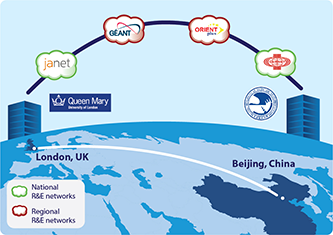Education

TNE: taking global learning to a new level
Transnational Education (TNE) is growing at a brisk pace across the globe. Academic institutions are collaborating to jointly teach students who are benefitting from high quality teaching, locally, without needing to travel abroad. TNE activities are varied from remote campuses to joint degree programmes with institutions sharing best practice on a worldwide scale. All TNE activities are underpinned by high-speed networks such as Janet, the UK’s national research and education network (NREN), provided by JISC, CERNET (in China), and international links such as ORIENTplus which make essential teaching activities such as delivering courses, sharing lectures in real-time and running video-based, international tutorials possible.
Sharing teaching and learning between the UK and China
The UK is the largest global provider of TNE, with the greatest proportion of projects involving collaboration with Chinese institutions. The joint programme between Queen Mary University of London (QMUL) and Beijing University of Posts and Telecommunications (BUPT) is an innovative example of TNE. Set up in 2004, it offers Chinese students access to a series of jointly run degree programmes in telecommunications systems and networks. The partnership is genuinely equal – students graduate with degrees from both institutions and teaching is split 50/50 between the universities. 2,500 students are currently enrolled on the course, with numbers set to reach 2,800 by 2017. They all benefit from the blend of skills and cultures delivered by this unique approach.
The need for high-speed networking
Digital communications is an effective and cost-efficient means for delivery of these courses; lectures and tutorials are provided by real-time video, voice and instant messaging (IM) technology, while bandwidth-intensive Virtual Learning Environments (VLEs) underpin course work and email for communication with students. While teaching staff from the UK visit China to give lectures and tutorials (through the ‘Flying Professor’ model), this actually increases network demands, as coursework is then marked remotely and follow-up tutorials are delivered online.
Understanding the growing importance of transnational education to UK academic institutions, Jisc launched its TNE Support Programme in 2013. The programme aims to address UK universities’ requirement for cost-effective and reliable connectivity services to overseas TNE locations.
As part of the programme Jisc signed a Strategic Alliance with Chinese NREN CERNET. This aims to support universities such as QMUL by providing the connectivity and services they need, and includes use of the high-speed 10 Gbps London-Beijing ORIENTplus connection for TNE activities in China.
The default route for internet traffic between Europe to China is via the US and Pacific. The combination of distance and network congestion had previously led to latency issues for the QMUL/BUPT TNE, which meant that staff and students could not access IT and teaching systems located in the UK. This hindered teaching, damaged the student experience and impacted on the quality of the programme.
Since the TNE Support Programme has been launched the results have been dramatic. By routing traffic through ORIENTplus, rather than via the US, latency has nearly halved (from 350ms to 180ms), ensuring that teaching and learning systems work seamlessly in both countries. This makes a major difference to the learning experience enabling students and staff to work together, despite being separated by thousands of miles. Courses can be delivered from the UK, reducing the need for staff travel and making best use of existing UK-based lectures and teaching. Real-time video conferencing is expected to increasingly complement face to face tutoring, while students can share the virtual learning system, libraries and other facilities hosted in the UK without interruption. Additionally, operational management is improved, as access to QMUL’s UK-based administration systems is faster for those in China, increasing efficiency and communication.
Facilitating real-time knowledge transfer
By sharing academic knowledge and teaching methods transnational education helps increase skills across the globe, building a collaborative, worldwide community of students and academics. Thanks to their capacity, speed and reliability high-speed networks are at the heart of TNE’s growth and future success.
“The Flying Professor model means that we have increased communication with large numbers of students. We tried many solutions, but the best one was clearly working with Jisc. The Strategic Alliance between CERNET and Jisc, and access to ORIENTplus has already provided definite benefits.”
Dr Yasir Alfadhl, Flying Faculty Lecturer, Queen Mary University of London (QMUL)
“The joint degree course offered by QMUL and BUPT attracted me as it brings together the best of the Western and Chinese models. Previous connectivity problems hindered some of my learning and following the connectivity resolution, I was able to work together in real-time with teachers thousands of miles away without any problems. This has improved my skills and personal development.”
Mr Guangwei Jiang, former joint programme student and now PhD student at QMUL
The Challenge
Teaching on the Transnational Education (TNE) programme between Queen Mary University of London (QMUL) and Beijing University of Posts and Telecommunications (BUPT) was being disrupted by slow network connections that made it impossible for students and staff to access shared systems and carry out joint teaching activities.
The Solution
Through the Jisc TNE Support Programme, QMUL is now able to use the high-speed ORIENTplus connection to link via the Janet and CERNET networks to BUPT. This provides a direct connection between Europe and China, rather than the previous solution which was routed via the Pacific and United States.
Key Benefits
By using ORIENTplus, the quality of teaching has been improved and the student experience transformed. Vital teaching, learning and administration systems, including real-time video and Virtual Learning Environments, work seamlessly between the UK and China, as latency has been nearly halved between QMUL and BUPT.
Read the full version of case study (PDF) *
*Produced in 2014 during the ORIENTplus project

